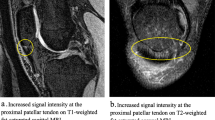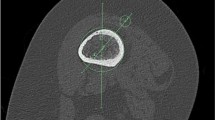Abstract
We studied the range of appearance of asymptomatic patellar tendons and evaluated the effect of age, weight, joint effusions, and anterior cruciate ligament (ACL) tears on this tendon. One hundred and seventy-three patellar tendons in asymptomatic patients were studied at 1.5 tesla. Sagittal short and long TE images were evaluated in regard to tendon thickness, ratio of thickness of patellar to quadriceps tendons, frequency, location, and severity of intratendon signal, and frequency and severity of tendon buckling. Results were correlated with patient age, sex, weight, the presence of ACL tears, and relative volumes of joint fluid. The mean thickness of the patellar tendon was 0.52 cm. The patellar to quadriceps tendon ratio was 0.72. The patellar tendon frequently (74%) had focal areas of signal apparently within it. This signal was usually subtle, V-shaped (95%), and seen posteriorly in the proximal end of the tendon (82%). Intratendon signal was also seen commonly in the inferior aspect of the tendon (32%). This signal intensity did not increase with greater T2-weighting (99%). Buckling of the patellar tendon was a frequent asymptomatic variant (71%) but was also associated with joint effusions (p<0.01) and ACL tears (p=0.01). Buckling, intratendon signal, and tendon thickness increased with weight and age. Variation of the magnetic resonance appearance of the patellar tendon is frequent. Many of these changes appear to represent subclinical degeneration. Buckling of this tendon also may occur secondary to joint effusions or ACL tears.
Similar content being viewed by others
References
Amiel D, Billing E, Akeson D (1990) Ligament structure, chemistry and physiology. In: Daniel D (ed) Knee ligaments: structure, function, injury. Raven, New York, pp 77–79
Berlin RC, Levinsohn EM, Chrisman H (1991) The wrinkled patellar tendon: an indication of abnormality in the extensor mechanism of the knee. Skeletal Radiol 20:181
Bodne D, Quinn SF, Murray WT (1988) Magnetic resonance images of chronic patellar tendonitis. Skeletal Radiol 17:24
Cobby M, Schweitzer ME, Resnick D (1992) The deep lateral femoral notch: an indirect sign of a torn anterior cruciate ligament. Radiology 184:855
Davies SG, Baudonin CJ, King JB, Perry JD (1991) Ultrasound, computed tomography and magnetic resonance imaging in patellar tendonitis. Clin Radiol 43:52
DeFlavis L, Nessi R, Scagliae P, Balconi G, Albisetti W, Derichi LE (1989) Ultrasound diagnosis of Osgood-Schlatter and Sinding-Larsen-Johannson diseases of the knee. Skeletal Radiol 18:193
Edstrom L (1970) Selective atrophy of red muscle fibers in the quadriceps in long standing knee joint dysfunction: injuries to the anterior cruciate ligament. J Neurol Sci 11:551
El-Koury GY, Wira RL, Berbaum RS, Pope TL, Monu TUV (1992) MR imaging of patellar tendonitis. Radiology 184:849
Evans EJ, Benjamin M, Pemberton DJ (1990) Fibrocartilage in the attachment zones of the quadriceps tendon and patellar ligament in man. J Anat 171:155
Ferretti A, Ippolito E, Mariani P, Puddu G (1993) Jumper's knee. Am J Sports Med 15:58
Fritschy D, deGantad R (1988) Jumper's knee and ultrasonography. Am J Sports Med 16:637
Gould ES, Taylor S, Naidich JB, Furie R, Lane L (1987) MR appearance of bilateral, spontaneous patellar tendon rupture in systemic lupus erythematosus. J Comput Assist Tomogr 11:1096
Hall FM (1975) Radiographic diagnosis and accuracy in knee joint effusions. Radiology 115:49
Kalebo P, Swad L, Karlsson J, Peterson L (1991) Ultrasonography in the detection of partial patellar ligament ruptures (jumper's knee). Skeletal Radiol 20:285
Kannus P, Jozca L (1991) Histopathological changes preceding spontaneous rupture of a tendon: a controlled study of 891 patients. J Bone Joint Surg [Am] 73:1507
Kjellin I, Ho CP, Cervilla V, et al. (1991) Alterations in the supraspinetous tendon at MR imaging: correlation with histopathologic findings in cadavers. Radiology 181:837
Lee SK, Yao L, Phelps CT, Wirth CR, Czajka J, Lozman J (1988) Anterior cruciate ligament tears: MR imaging compared to arthrography and clinical tests. Radiology 166:861
Martens M, Wonters P, Burssens A, Mulier JC (1982) Patellar tendonitis pathology and results of treatment. Acta Orthop Scand 53:445
Mink JH, Levy T, Crues JV (1988) Tears of the anterior cruciate ligament and menisci of the knee: MR imaging evaluation. Radiology 167:769
Nance EP, Kaye JJ (1982) Injuries of the quadriceps mechanism. Radiology 142:301
Nisell R, Ekholm J (1985) Patellar forces during knee extension. Scand J Rehab Med 17:63
O'Conner J, Shercliff T, Fitzpatrick D, Biden E, Goodfellow J (1990) Mechanics of the knee. In: Daniel D (ed) Knee ligaments: structure, function, injury. Raven, New York, pp 77–79
Pope CF (1992) Radiologic evaluation of tendon injuries. Clin Sports Med 579
Reicher MA, Bassett LW, Gold RH (1985) High resolution magnetic resonance imaging of the knee joint: pathologic correlations. AJR 145:903
Reicher MA, Hartzman ST, Bassett LW, Mandelbaum B, Duckwiler G, Gold RH (1987) MR imaging of the knee. Part I. Traumatic disorders. Radiology 162:547
Reider B, Marshall JL, Koslin B, Ring B, Girgin FG (1981) The anterior aspect of the knee joint. J Bone Joint Surg [Am] 63A:351–356
Schlerzka D, Schwesinger G (1990) The height of the patella. Eur Rad 11:19
Schweitzer ME, Cervilla V, Kursunoglu-Brahme S, Resnick D (1992) The PCL line: an indirect sign of anterior cruciate ligament injury. Clin Imaging 16:43
Schweitzer ME, Faulk A, Berthoty D, Mitchell DM, Resnick D (1992) Knee effusion: normal distribution of fluid. AJR 159:361
Stoller DW, Martin C, Crues JU, Kaplan L, Mink JH (1987) Meniscal tears: pathologic correlation with MR imaging. Radiology 163:731
Terry GC (1989) The anatomy of the extensor mechanism. Clin Sports Med 8:163
Author information
Authors and Affiliations
Rights and permissions
About this article
Cite this article
Schweitzer, M.E., Mitchell, D.G. & Ehrlich, S.M. The patellar tendon: thickening, internal signal buckling, and other MR variants. Skeletal Radiol. 22, 411–416 (1993). https://doi.org/10.1007/BF00538442
Issue Date:
DOI: https://doi.org/10.1007/BF00538442




